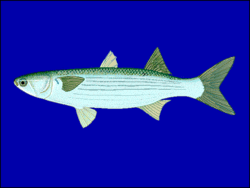Flathead mullet
| Flathead Mullet (Striped Mullet) | |
|---|---|
 | |
| Flathead Mullet (Striped Mullet), Mugil cephalus | |
 | |
| Conservation status | |
| Scientific classification | |
| Kingdom: | Animalia |
| Phylum: | Chordata |
| Class: | Actinopterygii |
| Order: | Mugiliformes |
| Family: | Mugilidae |
| Genus: | Mugil |
| Species: | M. cephalus |
| Binomial name | |
| Mugil cephalus Linnaeus, 1758 | |
The flathead mullet, Mugil cephalus, is a mullet of the genus Mugil in the family Mugilidae, found in coastal tropical and subtropical waters worldwide. Its length is typically 30 to 75 centimetres (12 to 30 in). This species occurs worldwide, attested by other common names for this fish:
- Black mullet - Cuba, US
- Bully mullet - Australia, Vietnam
- Callifaver mullet - Cuba, Netherlands Antilles, US
- Common grey mullet - UK
- Common mullet - Cuba, Netherlands Antilles, US
- Flathead grey mullet - India, Philippines (where it's known as either aligasid "gisaw""banak"talilong), UK
- Flathead mullet - Europe, FAO, UN, Fishbase
- Grey mullet - Thailand, Turkey, Australia, Taiwan, Cuba, Fiji, Hong Kong, Mauritius, Netherlands Antilles, New Zealand, Spain, Tonga, UK, US, Mediterranean, Egypt
- Hardgut mullet - Australia
- Mangrove mullet - Australia
- Sea mullet - Australia, Fiji, Papua New Guinea, UK
- Striped mullet - Australia, Cuba, Mexico, UK, US, Hawaii
- 烏魚 or 鲻魚 (Mandarin: wū-yú, zī-yú; Dieziu: ou-hêu, zeu-hêu) - South China
The Striped Mullet is a mainly diurnal coastal species that often enters estuaries and rivers. The Striped Mullet usually schools over sand or mud bottoms, feeding on zooplankton. The Adult fish normally feed on algae in fresh water. The maximum size the Striped Mullet may reach is approximately 120 cm, with a max weight of about 8,000 g. The species is euryhaline meaning that the fish can acclimate to different levels of salinity; this combined with the acclimation of juveniles to high water temperatures appears to be a selective advantage.[1]
Description
The Striped Mullet have dark centers which give the appearance of a series (6-7) of dark horizontal stripes. The fish grow to lengths up to 60.0 cm (24 inches) with weights as high as 4.0 kg (8.5 pounds).
Range
The Striped Mullet historically ranged far up the Colorado River to the vicinity of Blythe and up the Gila River to perhaps Tacna. Because of the dams and restricted flows to the Sea of Cortez, the range in Arizona is restricted to the Colorado River below Laguna Dam and the lower end of the Gila River when there is water present. The Striped Mullet are often abundant in the mainstream and lateral canals in the Gila River region.[2]
Habitat
The Striped Mullet normally occupies fresh, brackish and marine habitats in depths ranging between 0–120 metres (0–394 ft) and with temperatures between 8–24 °C (46–75 °F). In the Colorado River mullet are pelagic in larger pools, sometimes moving into currents below dams, and generally occurring in small groups.[1]
Population trends
The Striped Mullet populations are currently declining in Arizona, due to periods when the Colorado River does not reach the Sea of Cortez.
Cuisine

The flathead mullet is an important food fish for many around the world, and can be both fished and farmed. The roe of this mullet is salted, dried, and compressed to make a specialty food across the world, such as Greek avgotaraho, Taiwanese Wuyutsu, Korean myeongran jeot, Japanese karasumi, Italian bottarga, Turkish Haviar and Egyptian batarekh. In Egypt, the fish itself is salted, dried, and pickled to make feseekh.[3]
On the coast of Northwest Florida and Alabama, this mullet, called the striped or black mullet, is often a specialty of seafood restaurants. Fried mullet is most popular, but smoked, baked, and canned mullet are also eaten. Local fishermen usually catch mullet in a castnet, though some use a hook. Mullet is a delicacy in this area and is most often consumed in the home. Mullet are usually filleted, and the remaining frames used for fish stock, used in chowders and stews.[4] The mullet most commonly consumed in Florida however is the white mullet (mugil curema), because its preference for cleaner water gives it a cleaner and less muddy taste.[5]
Mullet does not keep well after it is caught. If kept on ice it may remain edible for approximately 72 hours, after which it becomes nearly inedible. The sooner it can be eaten after being caught, the better.
Notes
- ↑ 1.0 1.1 Minckley, W.L. 1973. Fishes of Arizona. Arizona Game and Fish Department, Phoenix. pp. 257-258.
- ↑ ARIZONA GAME AND FISH DEPARTMENT HERITAGE DATA MANAGEMENT SYSTEM
- ↑ "Mugil cephalus". Integrated Taxonomic Information System. Retrieved 18 April 2006.
- ↑ Instituto Veneto di scienze, lettere ed arti environmental database on the pool of Venice
- ↑ McKee, David (2008). Fishes of the Laguna Madre. College Station, Tx: Texas A&M University Press. p. 196. ISBN 978-1-60344-028-8.
References
- "Mugil cephalus". Integrated Taxonomic Information System. Retrieved 18 April 2006.
- Froese, Rainer and Pauly, Daniel, eds. (2006). "Mugil cephalus" in FishBase. January 2006 version.
- Tony Ayling & Geoffrey Cox, Collins Guide to the Sea Fishes of New Zealand, (William Collins Publishers Ltd, Auckland, New Zealand 1982) ISBN 978-0-00-216987-5
- Economic marine fishes of Hong Kong
- Instituto Veneto di scienze, lettere ed arti environmental database on the pool of Venice
| ||||||||||||||||||||||||||||||||||

